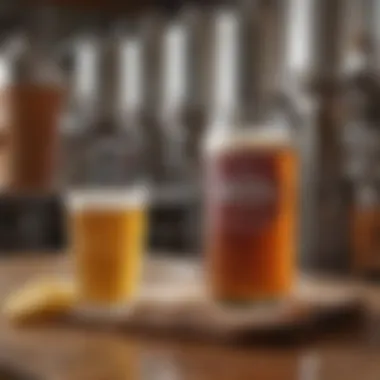Exploring Craft Beer: Quality NA Options for You


Intro
The consumption of non-alcoholic craft beer is on the rise, reflecting a significant shift in the beverage industry. More consumers are seeking alternatives that provide the flavor and enjoyment of traditional beer without the effects of alcohol. Exploring this niche reveals a growing variety of options tailored to those who appreciate craft brewing.
Understanding the nuances of non-alcoholic craft beer involves delving into the culture of craft beer itself. This section serves as an introduction to the broader landscape, providing insight into why non-alcoholic options have gained popularity in recent years. With evolving taste preferences and lifestyle choices, the demand for high-quality beverages that cater to a sober lifestyle has never been higher.
"Craft beer culture is about innovation and quality; non-alcoholic options reflect that ethos."
As we traverse this journey, we will examine the brewing processes that distinguish non-alcoholic beers from their alcoholic counterparts. Additionally, insights on how to find these beverages locally will empower readers to explore new flavors and brands. Through this exploration, the aim is to encourage an appreciation for well-crafted non-alcoholic beers and to enhance the choices available to consumers.
Intro to Craft Beer
Craft beer represents a significant movement within the beverage industry, emphasizing quality, flavor, and traditional brewing methods. This section lays the foundation for understanding the craft beer landscape, particularly the emergence of non-alcoholic variants. The importance of exploring craft beer lies in its unique ability to bring together community, creativity, and a focus on superior ingredients.
Definition of Craft Beer
Craft beer is typically defined by its production in small quantities, distinct attributes, and independent ownership. Unlike mass-produced beers, craft breweries prioritize artistry over scaling operations. This dedication often results in diverse flavor profiles and innovative brewing techniques. The fundamental elements of craft beer include:
- Brewed by Small Independent Breweries: Generally, craft breweries produce fewer than six million barrels annually.
- Focus on Ingredients: Craft beer often uses traditional ingredients such as malted barley, hops, water, and yeast, steering clear of adjuncts for flavor enhancement.
- Variety and Experimentation: Craft brewers commonly experiment with styles, flavors, and brewing processes, leading to a wide array of unique beers.
The definition of craft beer can differ from country to country. For example, in the U.S., the Brewers Association sets specific guidelines. Understanding these distinctions is crucial for anyone looking to delve into the rich world of craft beer.
The Rise of Non-Alcoholic Craft Beer
In recent years, there has been a notable surge in the popularity of non-alcoholic craft beer. This trend is not merely a fleeting fad but rather a response to changing consumer preferences. Many individuals are becoming more health-conscious, turning to alternatives that allow for social enjoyment without the effects of alcohol.
- Health Awareness: A growing understanding of alcohol's effects on health has led many to seek non-alcoholic options that maintain flavor without the intoxication.
- Quality Innovations: Breweries are investing in innovative brewing methods that enhance the quality and taste of non-alcoholic beers.
- Diverse Offerings: A wider spectrum of styles is now available, catering to various taste preferences and dietary considerations.
The importance of recognizing and exploring non-alcoholic craft beer cannot be understated. It merges the pleasure of traditional craft beer with a commitment to healthier lifestyles, making it an essential part of the contemporary craft beer narrative.
Cultural Impact of Craft Beer
Craft beer has woven itself into the fabric of modern society in remarkable ways. It reflects not only the creativity of individuals but also shapes communal experiences. As craft beer continues to rise in popularity, its influence extends beyond mere consumption. Understanding this impact is crucial for grasping the full essence of non-alcoholic craft beer as it finds its place alongside traditional options.
Community and Local Breweries
Local breweries serve as hubs for community engagement. They foster a sense of belonging among craft beer enthusiasts. These spaces provide opportunities for locals to gather and share stories over a pint, whether it's alcoholic or non-alcoholic. This social aspect is vital as it nurtures friendships and collaborative spirit.
Local breweries also support nearby economies. By sourcing ingredients from local farms and employing local staff, they create a positive feedback loop. Even non-alcoholic craft beers stemming from these breweries continue this trend, as they reflect regional tastes and preferences. Product offerings often emphasize unique flavors inspired by local heritage.
Non-alcoholic craft beer provides an inclusive option. Individuals who might abstain from alcohol for various reasons can still partake in the communal experience. This option gives space for everyone to enjoy the artisanal aspects of brewing. Whether at a pub, festival, or in the comfort of home, inclusivity is essential in strengthening community ties.
Craft Beer Events and Festivals
Craft beer events showcase the artistry of brewing. These gatherings bring together breweries and consumers in a celebratory atmosphere. Here, attendees can sample a wide range of flavors and styles, including non-alcoholic options. Events emphasize the knowledge and creative process behind each brew, enhancing understanding and appreciation.


Festivals often feature tastings, workshops, and panel discussions. These segments provide insights into brewing processes, flavor combinations, and industry trends. Attendees can immerse themselves in the craft, increasing awareness of non-alcoholic alternatives.
Engagement at these events also fosters dialogue. Consumers can directly interact with brewers, discussing their preferences and sharing experiences. This connection promotes a sense of trust and encourages growth within the craft beer community. Non-alcoholic craft beers gain recognition, leading to increased quality and variety in these offerings.
"Craft beer events encapsulate a celebration of creativity and community, showcasing not just the beverages, but the connections and knowledge behind them."
Understanding Non-Alcoholic Beer Options
In today’s beverage landscape, the perception of non-alcoholic beer is evolving. The importance of understanding non-alcoholic beer options cannot be overstated. With the rise in health consciousness, people are increasingly looking for alternatives to traditional alcoholic beverages. Non-alcoholic craft beers are designed to cater to those preferences, providing a satisfying experience for the palate while maintaining a lower alcohol content.
This section will delve into the brewing processes, flavor profiles, and comparative analysis between non-alcoholic and regular beers. It helps consumers discover the benefits of these options, including maintaining social connections without the effects of alcohol and enjoying the rich flavors crafted by skilled brewers.
Brewing Process for Non-Alcoholic Beer
The brewing process of non-alcoholic beer often begins in much the same way as regular beer. Yeast is added to a mixture of water, malted grains, and hops. However, the key distinction lies in the alcohol removal process.
There are different methods to achieve this:
- Vacuum Distillation: Here, the beer is heated under a vacuum. This allows the alcohol to evaporate at a lower temperature, preserving more of the beer’s original flavors.
- Reverse Osmosis: This involves filtering out alcohol using membranes. It concentrates the beer’s flavors before the alcohol is added back to create balance.
- Cold Block Method: This is the newest technique where fermentation takes place, but the alcohol is removed through evaporation without compromising on taste.
Each of these methods strives to retain the unique character that defines craft beer while producing a beverage that can appeal to a wider audience.
Flavor Profiles of NA Craft Beer
The flavor profiles of non-alcoholic craft beer can be surprisingly diverse. Many brands are now focusing on creating brews that are complex and rewarding. Common flavor notes may include:
- Malty: Many non-alcoholic beers maintain a sweet, caramel-like taste.
- Hoppy: A range of floral or citrus flavors can emerge from the hops used.
- Fruity or Spicy: Additional ingredients like fruit or spices can add an interesting twist.
Some customers may expect lesser flavor in non-alcoholic products; however, many breweries have worked hard to ensure that their NA offerings do not compromise on taste. This increased complexity in flavor profiles showcases the creativity of craft brewers and their dedication to quality.
Comparative Analysis: NA vs Regular Beer
When considering non-alcoholic craft beer against its alcoholic counterpart, several factors come into play. While traditional beer boasts an alcohol content typically ranging from 4% to 7%, non-alcoholic options usually contain up to 0.5% alcohol by volume.
Here are some key comparisons:
- Flavor Complexity: As discussed, NA beers are capable of delivering rich flavors, often rivaling regular beers. Consumers should always explore diverse brands to find what appeals to them the most.
- Health Consciousness: Non-alcoholic beers often present fewer calories and can be a suitable option for those looking to maintain a healthier lifestyle without sacrificing flavor.
- Social Enjoyment: Enjoying NA beers allows individuals to partake in social drinking occasions without the implications of alcohol, fostering connections and shared experiences.
"Non-alcoholic beer represents a significant step forward in catering to a more health-conscious public while still embracing the rich tapestry of craft brewing."
With growing interest in these options, a deeper understanding of craft beers and their non-alcoholic alternatives can enhance experiences and choices in social settings.
Locating NA Craft Beer Near You
Locating non-alcoholic craft beer options is essential for anyone exploring this expanding segment of the craft beer market. This section serves to inform readers on how to find quality NA beer, allowing them to enjoy the unique flavors without the effects of alcohol. With awareness of the variety of options available, enthusiasts can navigate their local area effectively. Here we will cover several practical ways to locate these beverages.
Utilizing Online Resources


The first step in locating non-alcoholic craft beer is to tap into online resources. Websites dedicated to craft beer often have filters for non-alcoholic options, allowing users to search easily. CraftBeer.com is one such platform that provides useful insights. Additionally, beer rating websites like Untappd can be extremely helpful. Users can search for specific NA beers and learn about their taste and quality from others who have tried them.
Social media groups and forums, such as those found on Reddit, can also provide valuable recommendations and discoveries. Users share their experiences and suggest local breweries that craft non-alcoholic beers. Being active in these communities can lead you to lesser-known gems in the craft beer scene.
Local Breweries Offering Non-Alcoholic Options
Visiting local breweries is a rewarding way to discover non-alcoholic craft beer. Many breweries now create special NA versions of their popular brews. It's beneficial to check the brewery's website or call ahead to inquire about their offerings. Breweries like Athletic Brewing Co. and Heineken 0.0 have gained popularity, but many smaller local establishments also offer unique options.
Many breweries host tasting events and tap takeovers. Attending these events allows you to try a range of non-alcoholic beers in one visit, extending the experience beyond just a sample. Interacting with brewers will give a deeper understanding of their process and motivations for producing non-alcoholic options.
Exploring Craft Beer Shops and Retailers
Another effective way to find non-alcoholic craft beer is to explore local shops and retailers specializing in craft beverages. Many craft beer shops maintain a diverse selection, including NA options. Staff members in these shops often possess extensive knowledge of the products, making it easier for you to gather information on quality NA beers.
Look for retailers that focus on local or small-batch breweries. Consider wine and beer specialty stores that might also carry a range of non-alcoholic craft beers. When visiting these shops, check the labels for flavor profiles and production dates to ensure freshness.
Navigating the Taste and Quality
Understanding the taste and quality of non-alcoholic craft beer is crucial for enthusiasts and newcomers alike. As the market for non-alcoholic options expands, it becomes essential to distinguish between various flavors and brewing techniques. Navigating the taste and quality involves recognizing the components that contribute to an enjoyable drinking experience.
One benefit of understanding this section is that it prepares you to appreciate the craftsmanship behind non-alcoholic brews. Many brands strive to create flavors that rival their alcoholic counterparts. By delving into the nuances of taste, one can better enjoy these offerings. Additionally, knowledge of quality indicators can guide consumers in their purchasing decisions, ultimately leading to a more satisfying choice.
Popular NA Craft Beer Brands
Several brands have excelled in producing non-alcoholic craft beers that stand out for their flavor and quality. Here are a few noteworthy names:
- Athletic Brewing Co.
Athletic Brewing has gained a reputation for its high-quality non-alcoholic craft beers. The brands provide a variety of options, from IPAs to stouts, catering to diverse palates. - Heineken 0.0
Known for its global reach, Heineken’s non-alcoholic version aims to deliver the same taste as its classic beer. Its balanced flavor appeals to many who consider themselves beer lovers. - BrewDog
BrewDog has embraced the non-alcoholic trend with a range of unique styles. Their innovative flavors often push the boundaries of traditional brewing. - Partake Brewing
This brand focuses exclusively on alcohol-free beers. Partake Brewing offers a selection of brews that highlight the craftsmanship and creativity found in craft beer. - Clausthaler
A pioneer in the non-alcoholic segment, Clausthaler has been producing quality beers for decades. Their commitment to flavor allows them to maintain a solid presence in the market.
Exploring these brands can significantly enhance your understanding of what non-alcoholic craft beer has to offer. Each of them showcases different styles and taste profiles, making the quest for quality both enjoyable and educational.
Tasting Techniques for Craft Beer Enthusiasts
Tasting non-alcoholic craft beer can be an enlightening experience, and using the right techniques enhances the overall enjoyment. Here are a few tasting methods:
- Visual Examination
Before tasting, observe the beer's color, clarity, and carbonization. Swirling the beer in the glass can reveal its aromatic properties. - Aroma Assessment
Take a moment to inhale the aroma. Different styles may present unique scent profiles. Notes of citrus, malt, or floral hints can provide insight into the beer's character. - Sipping Technique
When tasting, take a small sip and let it sit on your palate. This allows you to experience the flavor evolution as different components reveal themselves over time. - Mouthfeel Consideration
Pay attention to the texture and body of the beer. Some non-alcoholic brews might have a lighter feel, while others may mimic the rich mouthfeel typical of their alcoholic counterparts. - Finish Examination
Consider the aftertaste and how long the flavors linger. A well-crafted non-alcoholic beer should have a pleasant finish that invites another sip.
Keeping these techniques in mind can elevate the tasting experience from simple consumption to appreciating the artistry behind each brew.
Equipped with this knowledge, you are now better positioned to navigate the expanding world of non-alcoholic craft beer.
Food Pairings with Non-Alcoholic Craft Beer
Food pairings are an essential aspect of enjoying non-alcoholic craft beer. The right combination enhances the flavor experience for both the beverage and the dish. Understanding this harmony can influence your overall enjoyment. Moreover, non-alcoholic beers have unique flavor profiles that can complement various cuisines, making them a versatile choice.
Complementary Flavors


When considering food and non-alcoholic craft beer, specific flavor combinations can elevate a meal. The varied profiles of NA beers, from hoppy IPAs to rich stouts, enable diverse pairing opportunities.
- Hoppy Beers: These often have citrusy notes. Foods like grilled fish, salads with vinaigrette dressings, or spicy tacos work well. These flavors balance bitterness, providing a refreshing contrast.
- Malty Beers: These offer sweetness and caramel flavors. Barbecue ribs, roasted meats, or salted nuts pair excellently. The sweetness of the beer enhances the savory aspects of the food.
- Dark Beers: Stouts and porters lend themselves to desserts like chocolate cake or rich cheeses. Their depth of flavor adds complexity to these sweet or pungent profiles.
Experimenting with these pairings can yield surprising and enjoyable combinations. It’s about finding what excites your palate.
Creating an Enticing Meal Plan
Planning meals around non-alcoholic craft beer can be an enjoyable and engaging experience. A well-structured meal plan considers flavor balance, variety, and personal preferences.
- Starter: Begin with a light dish, such as a citrus-infused salad paired with a hoppy non-alcoholic IPA. This sets a fresh tone for the meal.
- Main Course: Choose richer dishes, such as grilled chicken marinated in a spicy sauce, accompanied by a malty beer. The combination here highlights textures and flavors.
- Dessert: Conclude with a decadent dessert, like a brownie, and complement it with a creamy stout. This offers a satisfying finish to the dining experience.
The art of pairing non-alcoholic craft beer with food is truly about balance and contrast.
By considering flavors and how they interact, you can create a complete dining experience centered around the enjoyment of non-alcoholic craft beers. Each course should not just satisfy hunger but also encourage exploration of tastes. This thoughtful approach can bring new life to meals, making every dinner an event to look forward to.
The Future of Non-Alcoholic Craft Beer
The landscape of non-alcoholic craft beer is evolving rapidly, marking a significant shift in consumer preferences and brewing practices. This section delves into what lies ahead for the non-alcoholic craft beer sector, emphasizing its relevance in today’s health-conscious society. As more consumers seek alternatives to traditional alcoholic beverages, the significance of non-alcoholic options becomes increasingly pronounced. This surge is fueled by a desire for inclusivity in social settings, an improved perception of health and wellness, and the quest for taste and variety. Non-alcoholic craft beer offers a unique solution, blending tradition with innovation to satisfy diverse palates without the effects of alcohol.
Trends in Craft Brewing
The trends shaping non-alcoholic craft beer are multifaceted. Breweries are experimenting with geographic ingredients and unique brewing techniques. For instance, the use of hops and grains to create complex flavors is becoming more prevalent. Furthermore, local ingredients are often highlighted to promote community connections, underscoring the importance of local sourcing and sustainability in brewing.
- Flavor Innovation: More breweries are focused on creating bold and diverse flavors. This includes incorporating fruits, spices, and even herbs.
- Healthier Ingredients: There is a noticeable shift towards using organic and wholesome ingredients, appealing to health-conscious consumers.
- Variety Expansion: The range of non-alcoholic options continues to grow, with styles ranging from IPAs to stouts, catering to a wider audience.
- Visibility in Retail: Non-alcoholic beers are becoming more visible in stores, reflecting a growing demand for these products.
This emphasis on creativity and quality allows non-alcoholic craft beer to compete without compromising on taste. Breweries that adapt to these trends may gain an advantage in a crowded market.
Consumer Attitudes Towards Non-Alcoholic Options
Consumer attitudes towards non-alcoholic craft beverages are shifting positively. Traditionally, these options were often seen as lesser substitutes. However, insights suggest that many now view non-alcoholic beers as a legitimate choice rather than just an alternative. A few key factors influencing this change include:
- Inclusivity in Social Settings: People desire to engage in social drinking without the downsides of alcohol consumption.
- Focus on Quality: Many consumers are willing to pay a premium for high-quality non-alcoholic beers, which indicates a significant shift in perception.
- Health Awareness: As health issues related to alcohol consumption gain more attention, consumers are looking for ways to enjoy their favorite flavors without the risks.
- Media Influence: Social media platforms have greatly influenced how these products are marketed, especially by highlighting craft beer enthusiasts who promote exploration.
"As the landscape of craft beverage continues to change, consumer choices will increasingly reflect their evolving preferences toward health, social inclusion, and quality experience."
These trends suggest that the future of non-alcoholic craft beer is bright and poised for growth. The willingness of consumers to embrace innovation will further drive the sector's development.
Culmination
Understanding the realm of non-alcoholic craft beer is essential for both casual drinkers and enthusiasts. This article has taken you through various aspects of NA craft beer, from its definition to its growing popularity in the world of beverages. Exploring non-alcoholic options opens avenues for individuals seeking flavorful and quality alternatives without the effects of alcohol.
Encouraging Exploration and Enjoyment
Encouraging individuals to explore the diverse offerings of non-alcoholic craft beer can lead to a deeper appreciation for brewing artistry. Each glass of NA beer serves as a reflection of innovation and dedication from brewers who aim to create enjoyable drinking experiences. Here are a few reasons why you should dive into this niche:
- Variety of Flavors: NA craft beers come in multiple styles, from richly flavored stouts to refreshing IPAs.
- Social Inclusion: Enjoying a craft beer taste while engaging with friends or at events can enhance social experiences without the downsides of alcohol.
- Health Conscious Choices: With lower calorie counts, non-alcoholic options help maintain a healthier lifestyle while still allowing for the pleasure of craft beer flavors.
Exploration can take many forms, whether it be visiting local breweries that feature NA options or experimenting with new brands during your next meal. Quality NA craft beer provides an excellent opportunity to enjoy unique flavors without compromising social interactions or health goals.
Exploring non-alcoholic options enhances not just health benefits but also the richness of experiences with craft beer.
In summary, embracing the culture of non-alcoholic craft beer allows for broader experiences, greater social engagement, and a chance to support local breweries. As the market continues to expand, staying informed and proactive about available options is key to discovering the full potential of this growing trend.







